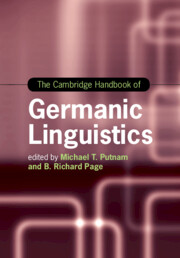Book contents
- The Cambridge Handbook of Germanic Linguistics
- Cambridge Handbooks in Language and Linguistics
- The Cambridge Handbook of Germanic Linguistics
- Copyright page
- Contents
- Figures
- Maps
- Tables
- Contributors
- Acknowledgments
- Germanic Languages
- Part I Phonology
- Part II Morphology and Agreement Systems
- Chapter 9 Verbal Inflectional Morphology in Germanic
- Chapter 10 Inflectional Morphology
- Chapter 11 Principles of Word Formation
- Chapter 12 Grammatical Gender in Modern Germanic Languages
- Chapter 13 Case in Germanic
- Chapter 14 Complementizer Agreement
- Part III Syntax
- Part IV Semantics and Pragmatics
- Part V Language Contact and Nonstandard Varieties
- Index
- References
Chapter 12 - Grammatical Gender in Modern Germanic Languages
from Part II - Morphology and Agreement Systems
Published online by Cambridge University Press: 31 March 2020
- The Cambridge Handbook of Germanic Linguistics
- Cambridge Handbooks in Language and Linguistics
- The Cambridge Handbook of Germanic Linguistics
- Copyright page
- Contents
- Figures
- Maps
- Tables
- Contributors
- Acknowledgments
- Germanic Languages
- Part I Phonology
- Part II Morphology and Agreement Systems
- Chapter 9 Verbal Inflectional Morphology in Germanic
- Chapter 10 Inflectional Morphology
- Chapter 11 Principles of Word Formation
- Chapter 12 Grammatical Gender in Modern Germanic Languages
- Chapter 13 Case in Germanic
- Chapter 14 Complementizer Agreement
- Part III Syntax
- Part IV Semantics and Pragmatics
- Part V Language Contact and Nonstandard Varieties
- Index
- References
Summary
Grammatical gender in modern Germanic languages displays strong variation. Some languages retain three adnominal genders (e.g., German, Icelandic), others reduced the system to two genders, usually by a merger of masculine and feminine gender (e.g., Dutch, Swedish). In English and Afrikaans, adnominal gender is completely lost. Pronominal gender, on the other hand, does not always reflect adnominal gender, and is retained in at least three genders in all Germanic languages. The chapter starts from the presentation of lexical gender systems in Germanic languages and dialects, reflecting the relevant assignment criteria. It then turns to pronominal gender systems, showing that mismatches, specifically between adnominal and pronominal genders, can result in a re-organization of gender systems. Since many Germanic languages retain a second class of nouns next to gender, namely declension classes, the interrelation between gender and inflection classes is subject of a final section before conclusions are drawn.
- Type
- Chapter
- Information
- The Cambridge Handbook of Germanic Linguistics , pp. 259 - 281Publisher: Cambridge University PressPrint publication year: 2020
References
- 1
- Cited by

